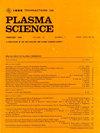航空电刷板深介质充电特性及绝缘优化研究
IF 1.3
4区 物理与天体物理
Q3 PHYSICS, FLUIDS & PLASMAS
引用次数: 0
摘要
在空间的极端电子辐射环境下,高能电子会使电刷板的绝缘部件发生深度介电充电,引起绝缘介质和相邻电刷放电,从而诱发太阳能电池阵列驱动组件(SADA)的绝缘失效,甚至导致整个卫星的失效。绝缘介质的材质、电刷的状态、电刷之间的距离等都能直接影响电刷板的放电阈值。因此,有必要对这些因素进行深入研究,以降低排放事故发生的可能性。为此,建立了电刷板绝缘构件的三维深充电模型,得到了电刷板绝缘构件的电场和电势的三维分布。研究了电刷板深度介电充电的时间特性。停止电子照射后,电刷板长时间保持在5kv以上的电势,存在放电危险。研究了材料组成对电刷板深度介电充电的影响,结果表明电刷板电导率最高,由60% YS $20+30$ % ZnO +5% GF +5% POSS材料组成,具有最强的电荷放空能力。在此基础上,利用ME-268A平板充电计验证了60% YS $20+30$ % ZnO +5% GF +5% POSS材料组成的电刷板具有良好的电荷输运特性和绝缘性能,并研究了电刷状态和电刷距离对充电电压的影响。结果表明,增大相邻电刷安装距离、电刷端部倒角、电刷外涂绝缘涂层等绝缘措施可提高相邻电刷间的静电防护能力。本文章由计算机程序翻译,如有差异,请以英文原文为准。
Research on Deep Dielectric Charging Characteristics and Insulation Optimization of Aerospace Electric Brush Plates
In the extreme electronic radiation environment of space, high-energy electrons can cause deep dielectric charging of the insulation components of the electric brush plate, causing discharge of the insulation medium and adjacent electric brushes, thereby inducing insulation failure of the solar array drive assembly (SADA), and even leading to the failure of the entire satellite. The material of the insulating medium, the state of the electric brushes, and the distance between the electric brushes can directly affect the discharge threshold of the electric brush plate. Therefore, it is necessary to conduct in-depth research on these factors in order to reduce the possibility of discharge accidents. To this end, a 3-D deep charging model of the insulation component of the electric brush plate was established, and the 3-D distribution of the electric field and potential of the insulation component of the electric brush plate was obtained. The time characteristics of deep dielectric charging of the electric brush plate were studied. After stopping electron irradiation, the electric brush plates remained at a potential of over 5 kV for a long time, posing a risk of discharge. The study investigated the effect of material composition on deep dielectric charging of electric brush plates, and the results showed that the electric brush plate with the highest conductivity, consisting of 60% YS $20+30$ % ZnO +5% GF +5% POSS material, has the strongest electric charge bleed ability. Further based on the distribution of deep dielectric charging potential on the electric brush plate, the ME-268A flat charge meter was used to verify that the 60% YS $20+30$ % ZnO +5% GF +5% POSS material composition electric brush plate has good charge transport characteristics and insulation performance, and the influence of electric brush state and electric brush distance on charging voltage was studied. The results indicate that insulation measures, such as increasing the installation distance of adjacent electric brushes, chamfering the electric brush ends, and coating the electric brushes with insulation coatings, can improve the electrostatic protection ability between adjacent electric brushes.
求助全文
通过发布文献求助,成功后即可免费获取论文全文。
去求助
来源期刊

IEEE Transactions on Plasma Science
物理-物理:流体与等离子体
CiteScore
3.00
自引率
20.00%
发文量
538
审稿时长
3.8 months
期刊介绍:
The scope covers all aspects of the theory and application of plasma science. It includes the following areas: magnetohydrodynamics; thermionics and plasma diodes; basic plasma phenomena; gaseous electronics; microwave/plasma interaction; electron, ion, and plasma sources; space plasmas; intense electron and ion beams; laser-plasma interactions; plasma diagnostics; plasma chemistry and processing; solid-state plasmas; plasma heating; plasma for controlled fusion research; high energy density plasmas; industrial/commercial applications of plasma physics; plasma waves and instabilities; and high power microwave and submillimeter wave generation.
 求助内容:
求助内容: 应助结果提醒方式:
应助结果提醒方式:


